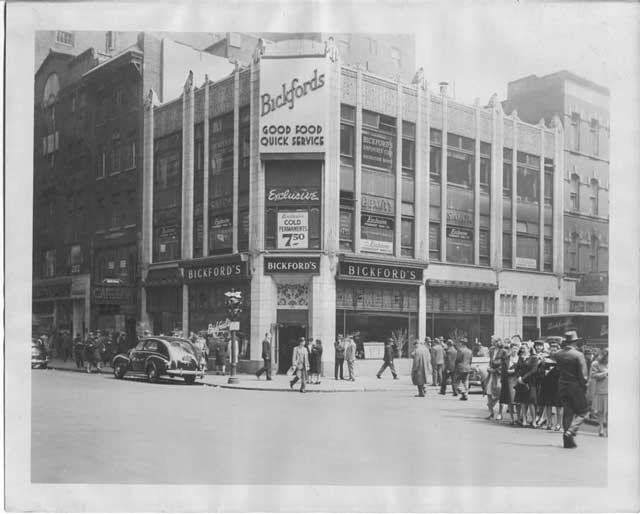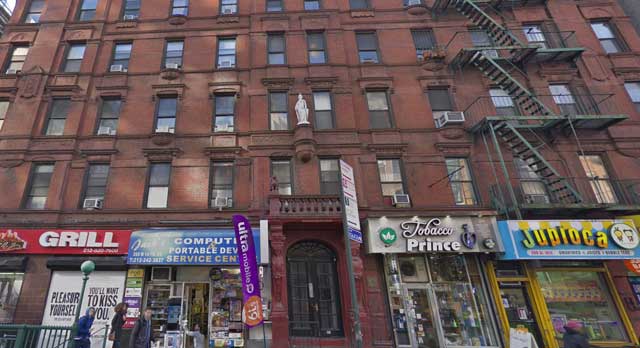14th Street and Seventh Avenue, NYC
 |
| Southwest corner of 14th Street and 7th Avenue, NYC, in 1972. |
I love the above photo from 1972 for a couple of reasons. First, it reminds me of the famous 1942 Nighthawks oil painting by Edward Hopper which hangs in the Art Institute of Chicago.
That happens to be a personal favorite of mine, and a print hangs in my dining room. At the time, Hopper had his studio at Washington Square and he mentioned in passing that the painting "was suggested by a restaurant on Greenwich Avenue where two streets meet." That could have been Greenwich Avenue at West 11th Street, a mere three blocks south of the location of the 1972 photo. Now, I'm not trying to make some outlandish claim that this photo reveals the true source of Hopper's inspiration, which is unknown and remains the subject of speculation.
 |
| The opposite, southeast, corner of 7th Avenue at 14th Street. This would have been in the background of Hopper's "Nighthawks" painting. Notice the second-floor windows and compare them to those in Hopper's painting. See any similarities? |
However, Bickford's Coffee Shop would have been in there in 1942, so I also cannot rule it out. If you want to point out some difference, note that Hopper admitted that he "simplified" the scene. Now, if I were to simplify the scene, I would do things like removing the subway entrance and make it all one window instead of several windows. That would make it more general and not confined to just Manhattan. Perhaps you will agree with me that the scenes are uncannily similar and this type of scene is what Hopper saw in Greenwich Village which inspired "Nighthawks."
 |
| 14th Street looking east toward 7th Avenue, NYC, in 1916. The Pentecostal Nazarene Mission Church, aka Pentecostal Church of the Nazarene, shown in this photo was located at 210 West 14th Street. That would place this photo on the south side of 14th Street just to the right of the location shown in the 1972 photo. The pastor then was the Reverend Mrs. I.M. Jump. In the distance can be seen the IRT 6th Avenue elevated line, which already was 35 years old in 2016. The 7th Avenue line which resulted in the construction of the subway station seen in the 1972 photo took place shortly after this photo was taken. |
Second, I love old photos of 14th Street. That is the least appreciated major cross street in Manhattan. The runner-up would be 23rd Street, but at least that has the Flatiron Building and Madison Square Park to give it an identity. All that 14th Street has is Union Square Park, also an underappreciated fixture that locals value more than visitors. Anyway, when I found the above 1972 photo taken on 14th Street, I decided to do
a comparison of 14th Street at 7th Avenue from 1972 to 2017.
 |
| Southwest corner of 14th Street and 7th Avenue, NYC, in September 2017 (Google Street View). Beyond, you can see the red building. |
The scene hasn't really changed much over the years. The subway stop which has been there since around 1916 and the architecture shows that we have the proper spot. The location across 7th Avenue that in 1972 was a pizza joint is now a bar and grill or computer repair shop, depending on exactly which storefront it inhabited. The red building across the street at 200 West 14th Street which forms the background of "Nighthawks" was built in 1901, so it already would have been weathered by the time Hopper saw it.
 |
| Bickford's ca. 1950. Bickford's was a large chain, and while this location looks quite similar to 7th Avenue at 14th Street, it likely was elsewhere. I think the lettering used by Bickford's back in the day was kind of reminiscent of that used by Hopper in Nighthawks, but you be the judge. |
The location of the Bickford's Coffee Shop is now the Regal Gourmet Deli. Bickford's was a chain of eateries founded by Samuel Longley Bickford (1885 - 1959) in 1922. It went public in 1929, which was a good time to go public for the business's owners, though not so much for people who bought the stock. Bickford's was one of the first great fast-food chains, with locations primarily in New York but also across the country, including Florida and California. A favored haunt of artists and writers, and it is not impossible that Hopper himself stopped in at this particular Bickford's on 7th Avenue and 14th Street, considering that his studio was nearby. Bickford's reached its peak in the 1950s, but it closed its last New York restaurant in 1982. While it is now down to only three locations in Massachusetts, Bickford's remains in business as of 2019.
 |
| Southwest corner of 14th Street and 7th Avenue, NYC, in September 2017 (Google Street View). |
Anyway, the 1972 photographer had a keen eye for atmosphere and most likely also recognized the similarities of that scene with Hopper's famous painting. It's a nondescript part of Greenwich Village now, but the southwest corner of 7th Avenue and 14th Street has a lot of history to it and a story to tell if you're willing to listen to it. Just to hammer this home: any resident of Greenwich Village can tell you that someone walking from Washington Square, where Hopper had his studio, to 14th Street and 7th Avenue, the site of our proposed location for "Nighthawks," would likely have used Greenwich Avenue - the very street that Hopper mentioned. One final thought - if Hopper made a true representation of the scene, it likely was not on Greenwich Avenue itself. Greenwich Avenue runs at an angle to surrounding streets. While the corner in "Nighthawks" is a normal 90-degree intersection, the corners on Greenwich Avenue are slightly different. Thus, Hopper almost certainly painted an intersection near Greenwich Avenue, not actually on it. And, our Bickford's location fits the bill. None of this is certain, we are just doing a little detective work based on the known facts.
 |
| 200 West 14th Street, as seen on the east side of 7th Avenue, NYC, November 2017 (Google Street View). |
It seems obvious that Hopper did not wish to reveal the precise location from which he took his inspiration in order to retain the mystique, the timeless and abstract quality, of "Nighthawks." So, he just tossed off that it was somewhere over there by Greenwich Avenue and left it at that. To me, the smoking gun is the red exterior with evenly spaced windows across the street from Bickford's which is reproduced so faithfully in the background of "Nighthawks." You could show me a thousand little bistros on corners that have some similarities, but I doubt you'll be able to find me another one in Greenwich Village with that exact background of a red building with windows identical to those in "Nighthawks" - and in 1942.
Thanks for visiting this entry in our "the more things change, the more they stay the same" series. The history of 14th Street is rarely noticed, but it is rich and evocative. Please visit some of our other entries in this series!
2019








No comments:
Post a Comment
Note: Only a member of this blog may post a comment.